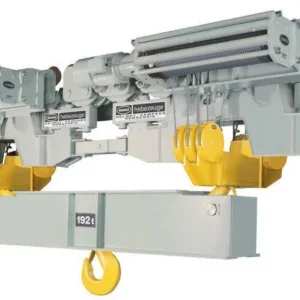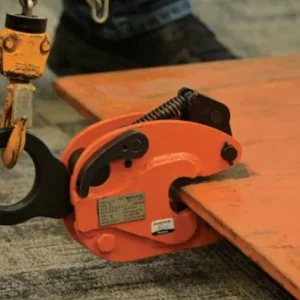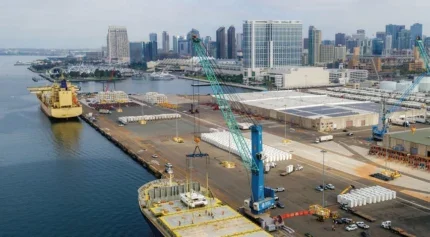
Removing politics from the equation, it remains clear that tariffs are impacting ports and terminals across North America – along with the companies who supply them with material handling equipment.
At the time of writing, Drewry’s highly regarded World Container Index (WCI) had fallen for the third consecutive week, following five weeks of gains. Drewry states that this decline is “a direct result of the low demand for US-bound cargo and is a sign that the recent surge in US imports, which occurred after the temporary halt of higher US tariffs, will not have the lasting impact we had initially expected”.
The American Association of Port Authorities (AAPA) pulled no punches in its response to tariffs. “Tariffs are taxes,” stated Cary Davis, AAPA president and CEO. “Though the port industry supports President Trump’s efforts to combat the flow of illicit drugs, tariffs will slow down our supply chains, tax American businesses and increase costs for hard-working citizens. Instead, we call on the administration and congress to thoughtfully pursue alternatives to achieving these policy goals and exempt items critical to national security from tariffs, including port equipment.”
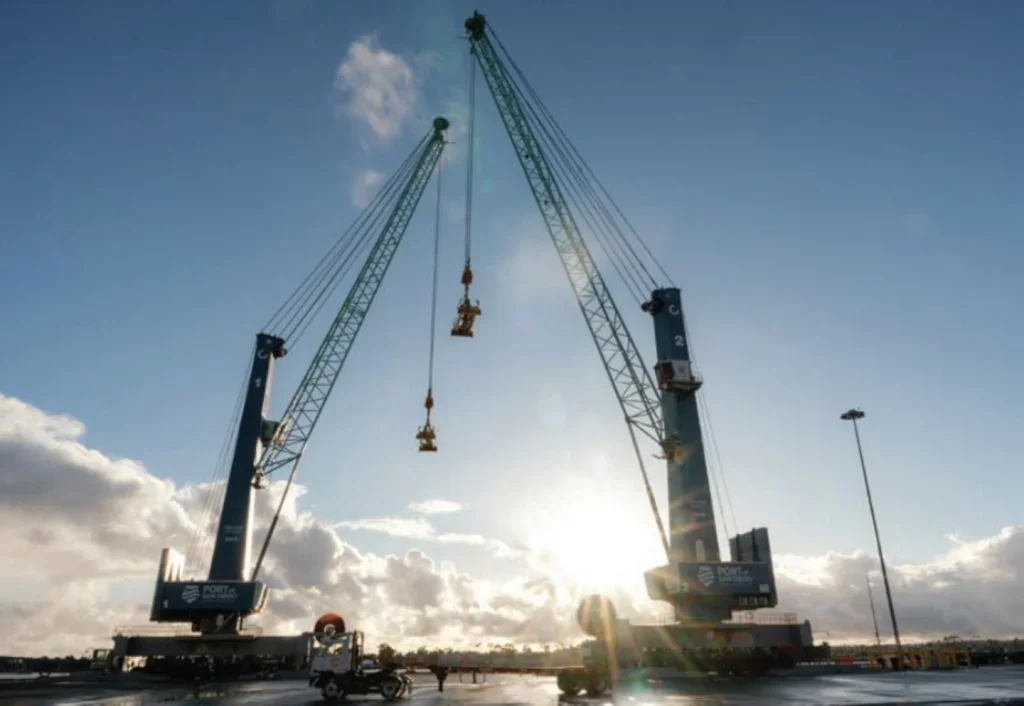
Like Drewry, Descartes Systems Group highlighted the scale of decline in its June Global Shipping Report for logistics and supply chain professionals. In May 2025, US container import volumes dropped after several months of growth, falling 9.7% from April and 7.2% year-over-year. Imports from China declined by 20.8% compared to April, marking the steepest monthly decline since March 2020 and by 28.5% compared to May 2024. Descartes also reported a shift in port dynamics in May, with east and gulf coast ports gaining market share over west coast ports. This is due to the west coast normally handling higher volumes of goods from China.
Port impacts
The Port of Los Angeles is a great example of this decline. The port broke records in September last year, handling 954,706 Twenty- Foot Equivalent Units (TEUs), a 27% increase over the previous year. This marked the close of the busiest quarter ever at the port.
Overall, 2024 was the port’s second busiest year in its 117-year history, processing more than 10.3 million container units, almost 20% more than in 2023.
This year started strongly but, by June, tariffs had started to bite – and the port was reporting declines. It processed 716,619 TEUs in May, 5% lower than the same month in 2024. After 10 straight months of year-on-year growth, overall cargo volume slowed due to the impact of tariffs on both imports and exports.
“May marked our lowest monthly cargo output in over two years,” said Port of Los Angeles executive director Gene Seroka when announcing the figures. “While May volume is typically stronger than April as we approach our traditional peak season, our imports dropped 19% compared to last month.
“Unless long-term, comprehensive trade agreements are reached soon, we’ll likely see higher prices and less selection during the year-end holiday season,” Seroka added. “The uncertainty created by fast-changing tariff policies has caused hardships for consumers, businesses and labour.”
The Northwest Seaport Alliance (NWSA) painted a similar picture. NWSA manages the container, breakbulk, auto and some bulk terminals in Seattle and Tacoma. Full international imports decreased 21.2% May 2025 versus May 2024, ending 14 consecutive months of month-over-month growth. The decline in May volumes reflect, in part, tariff uncertainty impacts to shipping decisions. Full international exports decreased 10.7%. Total container volume (international and domestic) for the month reached 250,851 TEUs, down 9.4% compared to May 2024. YTD volumes are up 10.2%, with full imports growing 12% and full exports declining 2.5%.
However, one ray of light was the Port of San Diego. Its strategy of diversification is once again helping it to weather the storm, as it did during the Covid-19 pandemic.
“Our various revenue streams have shown it to be a wise business model when it comes to volatility in our industry, keeping both of our terminals at Tenth Avenue Marine Terminal and National City Marine Terminal from suffering the extreme impacts of things like Covid and tariffs,” says Michael LaFleur, chief operations officer.
“As we saw during the supply chain issues during the pandemic, terminals that are dependent on container cargo experienced the most impacts. Less than 5% of our business is tied to China, and we receive minimal container cargo at our terminals.”
The port has a broad maritime business portfolio that includes dry bulk, refrigerated cargo, RORO, and specialty or project cargo. Crucially, San Diego also has a designated foreign trade zone (FTZ). These zones operate outside of US Customs territory, meaning that businesses within the FTA can benefit from reduced or deferred tariffs on goods entering the country.
“At this juncture of the various tariffs that have been placed on goods coming from several countries including China, the Port of San Diego is not experiencing a decrease in business,” he adds. “We will continue to monitor the ever-changing landscape of fees and tariffs that impact the movement of goods closely.”
Equipment providers
Naturally, tariffs are already impacting the order books for some material handling providers, while others say they are unaffected. “We’ve observed a noticeable slowdown in demand for container handling equipment, which aligns with the decline in cargo volumes moving through US ports,” says Andrew Ryan, president of LiuGong North America.
“Tariff uncertainty and shifting trade patterns have caused many port operators to pause or delay capital equipment investments as they reassess long-term needs under evolving global trade scenarios.”
However, he says that LiuGong views this as a period of recalibration rather than a permanent shift. While Chinese manufacturers are more exposed at present to tariffs, the company anticipates a renewed focus on equipment upgrades, efficiency improvements and sustainability investments at the port level.
“Regardless of the current climate, we remain committed to being a reliable, forwardthinking partner for the North American market,” he adds. “We’re continuing to build out our container handling portfolio and strengthening our support infrastructure so that, when port operators are ready to invest, we have the right solutions and the service network to support their success.”
Conversely, Liebherr Maritime Cranes has not seen a significant drop in demand. “In fact, interest remains steady,” says the company, “particularly in equipment that supports energy efficiency, automation and reduced emissions. Ports are looking ahead, and we are there to help them stay ready. This is not just about recovery but about building longterm resilience”.
Liebherr says it is focused on supporting ports with equipment that delivers longterm value, regardless of short-term market fluctuations. While it is aware that tariffs can influence global trade volumes, its experience shows that many ports continue to invest strategically in their infrastructure.
STS cranes issue
Of particular concern to ports and terminals are tariffs on Chinese-made STS cranes. Davis testified in a hearing before the Office of the United States Trade Representative (USTR) in May, in a bid to reverse them.
In official comments submitted to the Federal Register, Davis said: “Applying a new 100% tariff to Chinese STS cranes will not create a domestic crane manufacturing industry out of thin air. It will only increase costs for public port authorities.”
He added, “Raising tariffs on Chinese cranes another 100% will not magically revitalise an American crane manufacturing industry that has been non-existent for decades. It will, however, force public port authorities to pay more for the cranes already ordered or that they must order soon to replace aging equipment or outfit new terminals.”
AAPA says it remains committed to pushing back against additional tariffs on STS cranes and all goods that drive up the cost of shipping, increase expenses for ports and ultimately raise prices for everyday American consumers.
However, one company has already announced plans to manufacture STS cranes in North America. Stafford Cranes, which has a long history in tower cranes, last year announced it will produce a full range including STS, RTG and RMG cranes, under the Stafford Port Cranes brand.
Built in line with industry specifications, they will have capacities of up to 71t (78 US tons) in twin lift mode and up to 150t (165 US tons) in tandem lift mode. Stafford says they will offer lifting heights of up to 57m (187ft), rail spans reaching 50m (164ft) and outreach of up to 75m (264ft). The cabins will be supplied by Brieda Cabins.
Stafford is due to announce the US locations of its new manufacturing facilities shortly – although the cranes will be designed at its offices in Milan, Italy.
Sustainability drive
Beyond tariffs, ports remain focused on sustainability. Liebherr describes it as a clear shift towards cleaner, more efficient port operations, with growing momentum behind electric solutions, especially in ports facing stricter environmental regulations or community pressure to reduce emissions. “California is in the lead here, and regarding cargo handling equipment (CHE) at the ports, California is actively working on electrification efforts, especially for container and Ro-Ro terminals,” it says.
Compared to Europe, where electrification is more advanced due to regulatory incentives and infrastructure readiness, North America is progressing at a more varied pace. Some terminals are leading the way, while others are still exploring the best path forward. However, Liebherr is consistently seeing increased demand for equipment that balances performance with sustainability.
The company says it is supporting this transition with cranes that are adaptable to different energy strategies. “Our versatile drive systems, for example, offer a practical step toward lower emissions without requiring full electrification. And with our service hub in Miami and a strong regional presence, we are well positioned to help North American ports implement solutions that match their operational and environmental goals.”
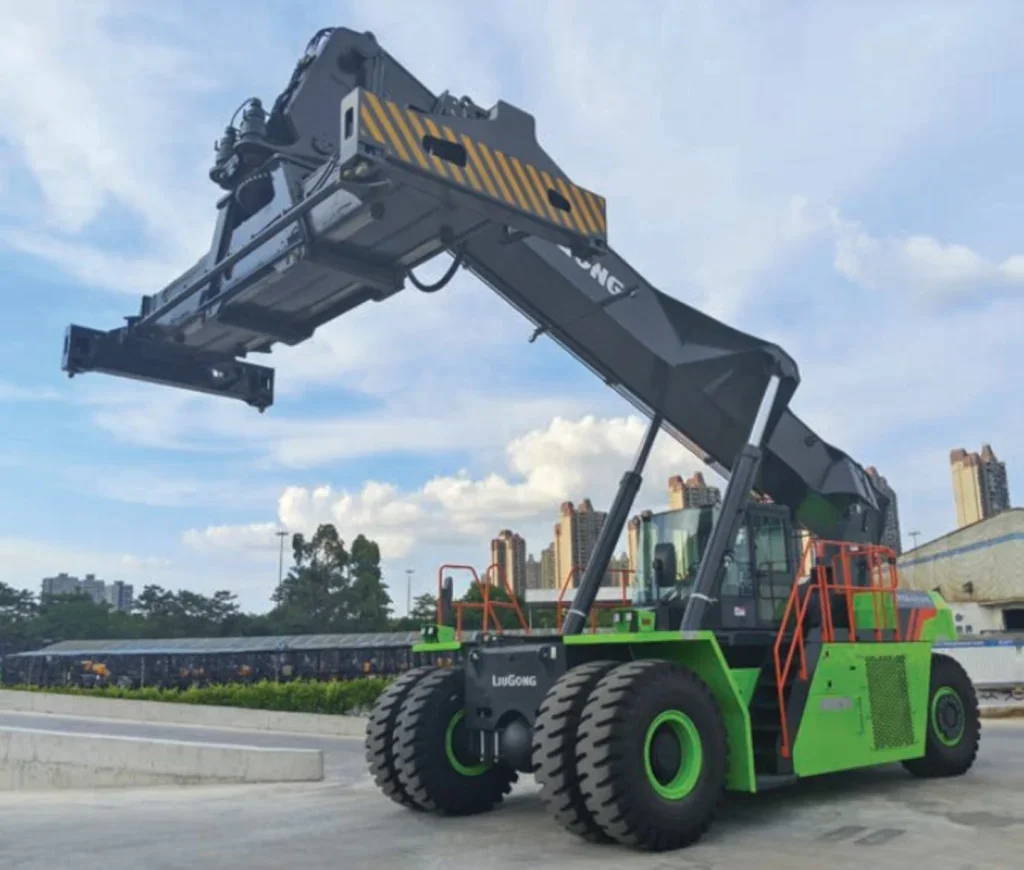
Undoubtedly, electrification of port equipment is moving at a slower pace in North America than in hotspots such as China and Europe.
“While the momentum is growing, the North American market remains in the early adoption phase for Class I electric equipment,” says Jared Ward, vice president material handling, LiuGong North America. He points out that Class V (internal combustion pneumatic) remain the dominant product class, followed by Class IV (internal combustion cushion tyre). “This reflects a preference for tried-and-true combustion-based machines, particularly in outdoor and heavy-duty applications where infrastructure for electrics is still developing.”
Ward sees rising demand for electric forklifts, particularly in warehousing and distribution environments, driven by tighter emissions regulations, sustainability initiatives, and advancements in battery technology. There is also increased focus on hybrid and fully electric cargo handling equipment at ports and terminals, where decarbonisation goals and environmental regulations are more aggressive.
However, cost and emissions reduction remain central themes. “Fleet operators are looking for solutions that lower the total cost of ownership while improving environmental performance,” he adds. “This is prompting investment in R&D and adoption of lithium-ion and other alternative power sources.”
Overall, while North America is behind Europe and China in terms of electrification maturity, the market is evolving steadily. “Infrastructure challenges, climate variability and fleet size diversity are contributing to the slower pace, but the trajectory is clearly towards a more electrified and efficient future.”
As an example, the Port of San Diego and its partners have invested or committed nearly $227m in zero emission technology and infrastructure projects, including new electric cranes. In fact, San Diego is the first port in North America to have two fully operational all-electric mobile harbour cranes. Manufactured by Konecranes, they replaced the port’s old diesel-powered crane.
“The conversion from a diesel-powered crane to an all-electric crane system is a big step toward achieving one goal of the Port’s Maritime Clean Air Strategy of transitioning all cargo handling equipment to zero emissions by 2030,” says LaFleur.
In addition to the public health and environmental benefits, the new cranes enable the port to compete for more business. LaFleur outlines how they represent the heaviest lift capability of any port crane system currently in place on the US West Coast – up to 400 metric tonnes (MT) tandem lift capacity.
“Most of the heavy-lift cargoes destined for this region weigh more than 200MT, including larger pieces of solar, wind and industrial energy equipment as well as project cargoes,” he says. “With their heavier capacity and faster offloading speed, the new cranes also better serve our existing operations when crane movements are needed.”
Some of the target cargo for the two cranes will be electric grid strengthening projects including geothermal, solar and wind farms in Arizona, Nevada, Southern California and Utah.
Hyster is adopting a blended approach, recognising that some companies are moving faster than others on electrification.
“We’re here to offer a solution that meets the customer where they are by providing the option they need,” the company says. “Our focus is modularity, in the sense that we offer a variety of electric power options, with the goal of providing flexibility to address the needs of customers in various regions and operational profiles.”
Data from the Industrial Truck Association shows that class I and II electric forklift trucks outsold class IV and V, which are ICE powered for four out of the past five years.
Of note to ports is that more OEMs are now offering electric options for applications with higher lift-capacity requirements. Hyster launched the J230-400XD earlier this year, expanding its lithium-ion power counterbalanced trucks to lift capacities up to 40,000lbs.
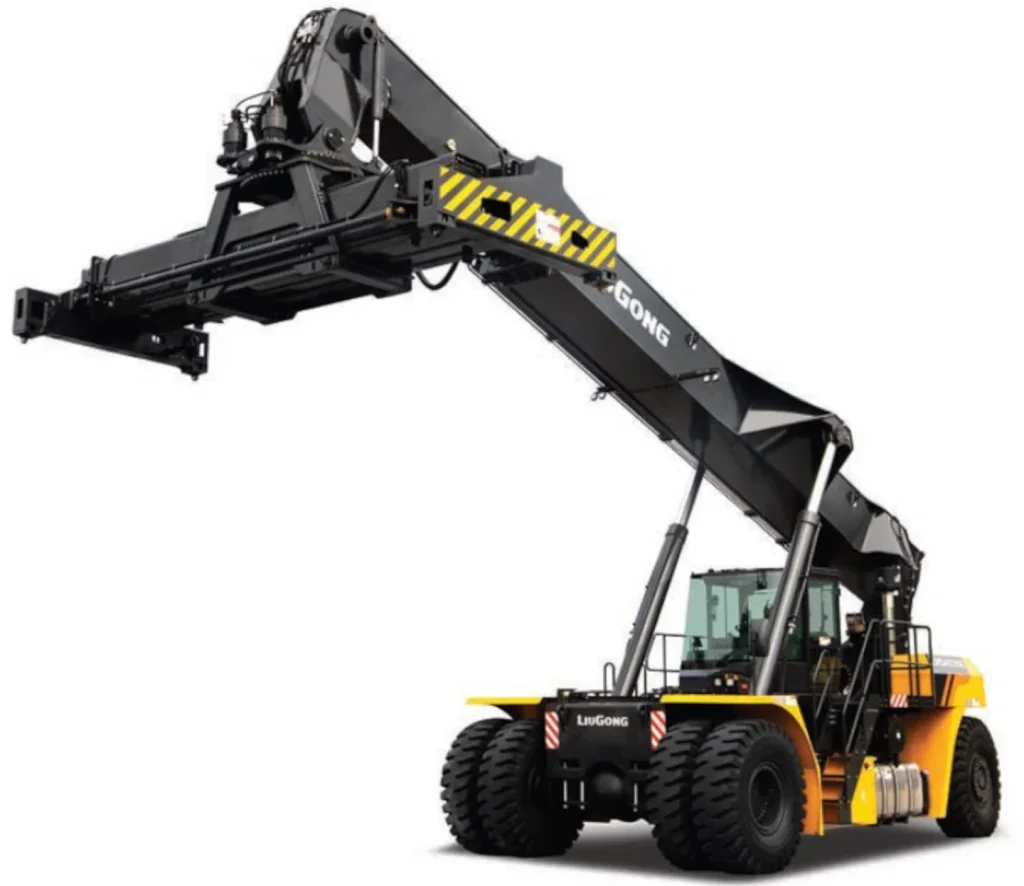
For container lifting, there is still a long way to go on the road to full electrification. “The electrification of container handling equipment at ports is in its infancy, but the landscape is evolving relatively quickly,” says Hyster. “Governments and companies are setting timelines for reducing emissions, and C-suite terminal executives with technology and sustainability responsibilities are considering the kinds of solutions that will be necessary to achieve those goals while satisfying the performance requirements of their operations.”
The company is already testing other technologies too. These include a hydrogen fuel cell-powered reach stacker at the Port of Valencia in Spain and an electric empty container handler at Malta Freeport Terminals in Southern Europe.
The company advises port operations not to rush into investing in electric equipment just because it is in use elsewhere. “It’s important to take a step back and evaluate key factors in your operation to determine what your best option is for electrification,” Hyster says. “The right power option for an operation will always depend on the specific application, and our approach is to help operations evaluate critical factors that can help point them toward the right option for their application.”
Future opportunities
Despite the current chaos, the long-term forecast remains positive for cargo handling equipment manufacturers.
Larry Courtney, product manager, material handling for LiuGong North America points out that ports across North America are under increasing pressure to adapt to a rapidly evolving logistics landscape. The rise in global shipping volumes, the growth of oversized and irregular cargo shipments and the push for greener operations are reshaping cargo handling requirements.
“One significant challenge we’ve identified is the handling of large or non-palletised cargo being shipped loosely within containers,” he adds. “Removing these items without causing damage either to the cargo or the container itself can be incredibly difficult with traditional equipment. This presents a clear opportunity for innovation and LiuGong is stepping up to meet it.”
The company is currently developing a line of Class IV forklifts with capacities up to 6t, designed to operate efficiently inside containers. “This is a strategic move that will expand our product portfolio and offer a practical solution in a segment currently dominated by competitors like Yale/Hyster and Toyota,” says Larry.
Overall, he believes that investing in more modern equipment will help ports address several challenges. They include rising container volumes and larger load sizes, demanding faster throughput and more flexible handling solutions; and a critical need to reduce downtime and increase operational efficiency across all areas of cargo handling.
Courtney lists the key benefits of LiuGong cargo handling solutions as high capacity lifting and reach for efficient container stacking and movement; reduced emissions with electric and low-consumption diesel options; lower operating and maintenance costs; and built for durability in harsh port environments.
“LiuGong is not only solving today’s cargo handling challenges, but we’re also helping ports prepare for the demands of tomorrow with purpose-driven innovation, practical design, and responsive support,” he concludes.
Meanwhile, Liebherr Maritime Cranes believes that the outlook is increasingly optimistic, with ports investing in modernisation to meet the needs of larger vessels, stricter environmental standards, and growing cargo volumes. “This includes replacing ageing equipment with solutions that are cleaner, more efficient and better integrated with digital systems,” it says.
“We are seeing strong interest in cranes that offer flexibility, both in terms of energy use and cargo handling. Versatile systems, modular designs and automation-ready features are becoming standard expectations rather than optional extras.”
The common thread across the world is a focus on resilience. Liebherr notes that ports want equipment that can adapt to changing conditions, support long-term sustainability goals and deliver consistent performance.
“Liebherr is well-positioned to support this shift. With a strong presence in North America and a global track record of engineering excellence, we are committed to helping ports meet today’s challenges and prepare for tomorrow’s opportunities.”



